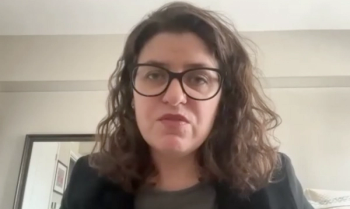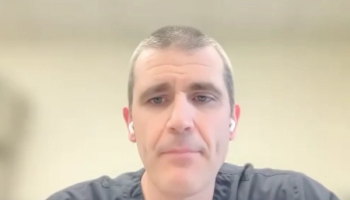
AUA 2021 BPH highlights with Dr. Steven Kaplan
Steven A. Kaplan, MD, gives an overview of benign prostatic hyperplasia research highlights from the 2021 American Urological Association Annual Meeting.
In this video, Steven A. Kaplan, MD, gives an overview of benign prostatic hyperplasia research highlights from the 2021 American Urological Association Annual Meeting. Kaplan is a professor of urology at the Icahn School of Medicine and director of the Men’s Wellness Program at Mount Sinai, New York, New York.
Transcript
Regarding BPH, I think there's many things that are of interest. Obviously, people always talk about therapies but there's an evolution of thinking about what the ultimate ceiling of medical therapy is. We had new guidelines that came out, so that's highlight number 1. They encompass medications, because we have not really reviewed medications or had recommendations for medication since 2011. So, there was a part for that, and it encompassed new medications that had been approved or used since 2011, including the PDE5 inhibitors like tadalafil, which had been approved for BPH, as well as medications for overactive bladder issues such as mirabegron. We didn't really comment about vibegron (Gemtesa) because there wasn't really data on it by the time we did a review.
We also made recommendations about various minimally invasive therapies and surgical therapies, but one of the big things we talked about is really defining treatment failure. And that's something that was discussed in 2021, but it's going to be an ongoing topic because it's variable. Most of the treatment failure data we have is based on clinical trials, and clinical trials are not the real world. It's very protocol-oriented and that's just not what happens. So, one of the things that we've advocated on the guidelines committee is to make sure that people have reasonable discussions with patients about expectations and managing expectations. With all that being said, the guidelines came out and we now have a new guidelines chairperson, Dr. Lori Lerner from Boston, who presented those new guidelines at AUA.
Regarding medical therapy, it’s not like discussing a whole bunch of new medications. Frankly, there are no new medical therapies. It's really discussing the typical prolonged data on UroLift and Rezūm, ongoing 5-year data, newer data, and there's not a lot of new twists. There's a debate about retreatment. We presented a late-breaking abstract that, if true, is going to really alter the way we think of things for multiple years going forward because treatment failure with Rezūm and UroLift was based on their own data. Rezūm presents about a 3.34% retreatment rate after 5 years, and for UroLift I don't know the exact numbers, but we always thought that they were a little bit higher than a TURP or a Greenlight because surgery works and shouldn't have a failure. So, we reviewed about 50,000 cases and we found that the retreatment rate at 1 year was much higher than we thought. The retreatment with Rezūm was 7.2%. And retreatment is exactly that—surgical retreatment. As clean of a definition as you can get. They needed another surgical treatment. For UroLift, it was about 5%-5.2%. For TURP, it was about 5.4%, which means that everything we've thought about surgery being great was wrong. Turns out there's a lot of retreatments at 1 year, so the gold standard or historical standards may not be as good as we thought. We're now delving deeper into the data to see if this is true at 2 years and 3 years, because if that's true, that's going to change a lot of the perceptions and also perhaps pave a perception of, "We're not going to pay for something if you're going to have a retreatment rate so high." Is this the peak, is it leveling off, or are we catching the upside? That's what we have to see. That was an important abstract and finding.
There's also new treatments that are being examined. There are a host of stents or metallic insertions. There are at least 5 companies that I'm aware of and that's on the horizon. They're doing their clinical trials. There is the Zenflow stent, the ProVerum stent…there's a whole bunch of stents out there. We also presented the 2-year data on what's called the Optilume, which I'm the principal investigator of. It's a drug-coated balloon, so it opens up the channel by doing what's called a commissurotomy. If you think of the prostate like an orange, the procedure splits it open at the top and then a drug is eluted called paclitaxel. That presumably decreases the inflammation, so it's like a 2-in-1 treatment. The data at 2 years was excellent. It's called the EVEREST trial.
I'm throwing a lot out here, but the good news is that it's a fertile area of research. I think now that we're learning more about whether a patient should be on 15 years of a medication for a quality-of-life disorder. Two medications? Three medications? Does it make sense when you can do a minimally invasive procedure? It may not be 1 and done, but even if you'll have to have something every 5 years, is that better than taking something by mouth with its own side effects? That's a very global thing, but it's good because I think future questions to investigate will be: Where will medication ultimately fit? Where will minimal invasive ultimately fit? Who would be the winners and losers in minimally invasive and even surgical modifications? There's also another device called the iTind device by Olympus, which was recently approved by the FDA. So, there are 3 devices that are being used that are FDA-approved, and that is the Urolift, Rezūm, and the iTind. The others are under investigation on the minimally invasive side.
Newsletter
Stay current with the latest urology news and practice-changing insights — sign up now for the essential updates every urologist needs.























